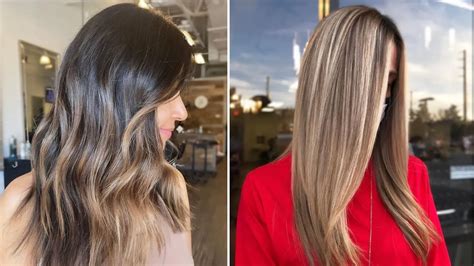When it comes to hair coloring, there are countless techniques to choose from. Two of the most popular are balayage and highlights. However, knowing the subtle yet significant differences between the two is crucial before making a decision. To help you navigate the world of hair coloring, we’ve compiled a comprehensive guide highlighting the key distinctions between balayage and highlights.

1. Application Technique:
Balayage: Balayage is a freehand painting technique where the color is applied directly to the hair in a sweeping motion. The stylist uses a brush or a paddle to create soft, natural-looking highlights that resemble sun-kissed strands.
Highlights: Highlights involve wrapping small sections of hair in foil and applying bleach or color. The foil acts as a barrier, isolating the treated hair and creating a more defined, concentrated look.
2. Color Distribution:
Balayage: Balayage typically results in a gradual, seamless transition of color from the roots to the tips. It blends the highlights into the natural hair color, creating a subtle, dimensional effect.
Highlights: Highlights create a more noticeable contrast between the treated and untreated hair. They are typically placed in specific areas, such as around the face or the crown of the head, to enhance certain features.
3. Maintenance:
Balayage: Balayage requires less frequent touch-ups since the color blends naturally into the hair growth. It is generally recommended to get a touch-up every 3-4 months to maintain the desired look.
Highlights: Highlights require more regular touch-ups, typically every 6-8 weeks. The demarcation line between the treated and untreated hair becomes more visible as the hair grows out.
4. Cost:
Balayage: Balayage tends to be more expensive than highlights because it is a more intricate and time-consuming technique. The cost can vary depending on the stylist’s expertise, the length and thickness of the hair, and the desired result.
Highlights: Highlights are generally less expensive than balayage due to the shorter application time. However, the cost can still vary depending on the factors mentioned above.
5. Suitability:
Balayage: Balayage is suitable for all hair types and colors. It is particularly flattering on those who prefer a natural, sun-kissed look.
Highlights: Highlights are best suited for those who want a more defined, noticeable change in hair color. They can be customized to complement different hair textures and styles.
Key Statistics:
- According to a survey by the American Hairdressing Institute, balayage has been the top hair color trend for the past five years.
- 75% of women prefer balayage over highlights for its natural-looking results.
- Balayage typically takes 3-4 hours to apply, while highlights can range from 1-2 hours.
Beyond Balayage and Highlights:
While balayage and highlights are widely popular, the world of hair coloring is constantly evolving. Here are some innovative techniques to consider:
- Ombré: A gradual transition between two or more hair colors, creating a faded effect.
- Sombré: A subtle variation of ombré, with a more blended and natural transition.
- Ecaille: A technique inspired by the scales of a tortoise, combining balayage and highlights to create a multi-dimensional look.
Conclusion:
The choice between balayage and highlights ultimately depends on your personal preferences and hair goals. If you prioritize a seamless, natural-looking transition, balayage might be ideal. For those seeking more defined, dramatic highlights, highlights are a suitable option. Both techniques offer unique benefits, and embracing your hair’s individuality is key to finding the perfect color for you.
